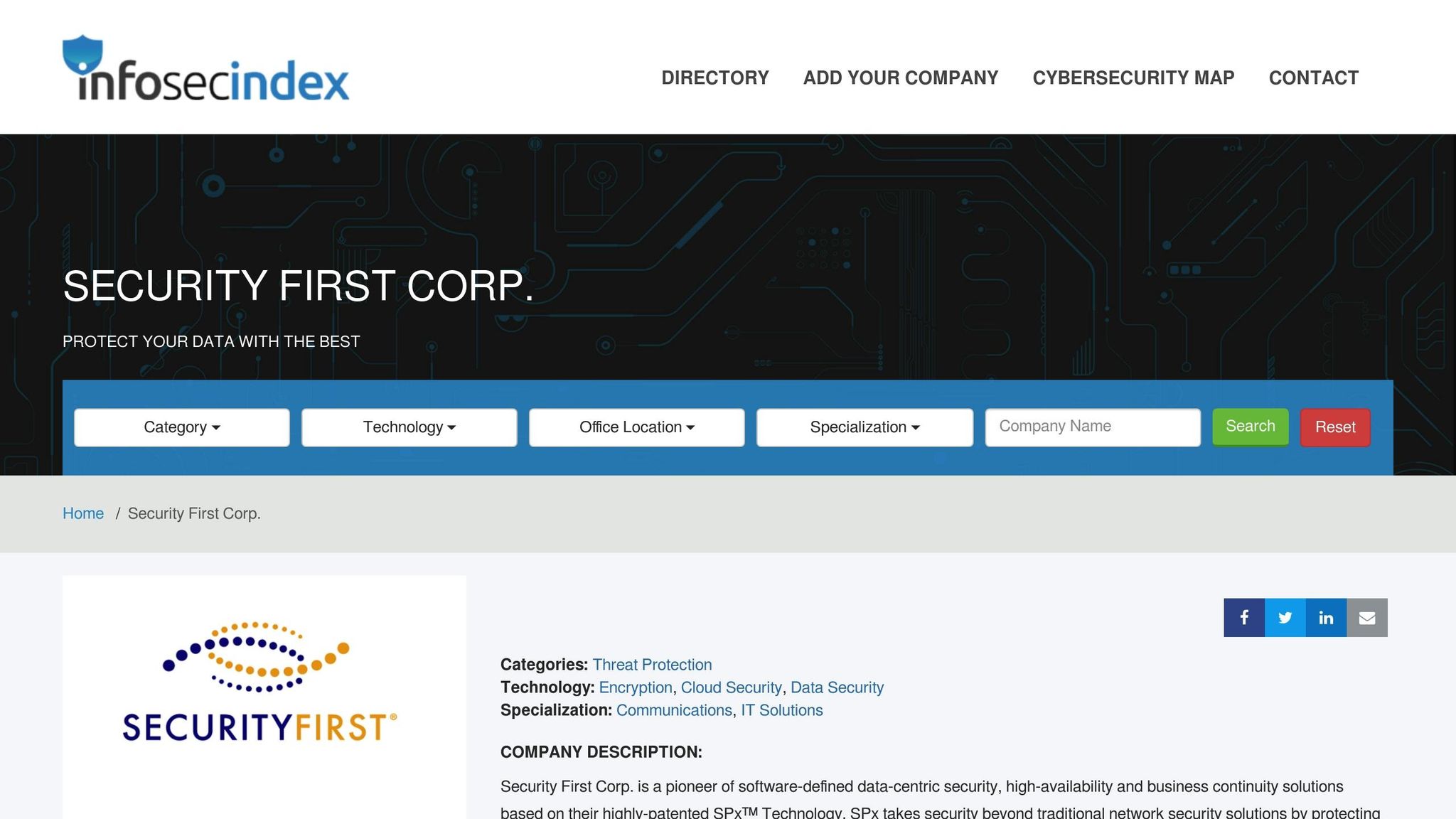Encryption is non-negotiable when it comes to protecting financial data in cloud environments. It ensures sensitive information remains secure, meets compliance requirements, and reduces financial risks. Here's what you need to know:
- Why Encryption Matters: Financial data is a top target for cyberattacks. Encryption safeguards data privacy and integrity, whether stored or in transit.
- Key Standards: AES-256 is the gold standard for encrypting stored data, while TLS 1.3 protects data during transmission. Both are widely trusted and effective.
- Regulatory Compliance: Laws like GDPR, CCPA, and PCI DSS require encryption to protect sensitive data and avoid penalties.
- Key Management: Effective encryption relies on secure key management practices, such as using hardware security modules (HSMs), automating key rotation, and avoiding hard-coded keys.
- Cloud Challenges: Multi-cloud setups and cross-border data rules complicate security. Encryption combined with strong access controls and regular audits mitigates these risks.
Encryption is a cornerstone of modern financial data protection, reducing breach costs (averaging $4.88M in 2024) and ensuring compliance with global regulations.
How Does Cloud Data Encryption Work? - SecurityFirstCorp.com

Main Encryption Standards and Protocols for Financial Data
To protect financial data stored in the cloud, financial institutions rely on well-established encryption standards. These protocols have been refined over decades through rigorous testing and regulatory oversight, ensuring robust and secure data systems.
Advanced Encryption Standard (AES)
Developed by NIST in 2001, the Advanced Encryption Standard (AES) is a symmetric encryption algorithm that processes data in fixed 128-bit blocks. It supports key lengths of 128, 192, and 256 bits. AES-256, which involves 14 rounds of encryption, is considered nearly impossible to break with current computing capabilities. Its efficiency compared to asymmetric methods like RSA makes it particularly suitable for encrypting large datasets, and it’s often the go-to choice for critical financial applications.
Proper key management is vital when implementing AES. Financial institutions should employ hardware security modules (HSMs) and follow strong key management practices to protect encryption keys. Additionally, using secure encryption modes - avoiding ECB and opting for authenticated modes like GCM or CCM - adds another layer of defense.
While AES is primarily used to secure stored data, protocols like TLS are critical for safeguarding data during transmission.
Transport Layer Security (TLS)
Transport Layer Security (TLS) is indispensable for protecting financial data as it moves between systems. By combining symmetric and asymmetric encryption, TLS ensures confidentiality, authentication, and data integrity. The Internet Society aptly describes its purpose:
"Transport Layer Security (TLS) encrypts data sent over the Internet to ensure that eavesdroppers and hackers are unable to see what you transmit which is particularly useful for private and sensitive information such as passwords, credit card numbers, and personal correspondence." – Internet Society
TLS 1.2 remains widely supported, securing 95.8% of websites, while TLS 1.3 adoption has grown to 64.8% of sites due to its enhanced security and performance. Operating on top of TCP, TLS protects application layer protocols like HTTP, FTP, SMTP, and IMAP, ensuring data in transit is shielded from threats like interception and tampering. Together, TLS and encryption at rest create a comprehensive data protection framework.
New encryption technologies are also being explored to complement these trusted methods.
New Encryption Technologies
Beyond established standards like AES and TLS, researchers are investigating advanced encryption techniques. One promising approach is Elliptic Curve Cryptography (ECC), which provides security comparable to RSA but with significantly shorter key lengths. This leads to faster processing and improved efficiency. While ECC and other emerging methods hold potential, financial systems today continue to rely on time-tested standards for their operations.
How to Implement Encryption in Cloud Environments
To safeguard data in cloud environments, encryption should be applied throughout the entire data lifecycle. Starting with strong encryption practices early can help prevent costly security vulnerabilities.
Encryption at Rest and in Transit
Data at rest refers to information stored in databases, file systems, or other storage locations when it’s not actively being transmitted. On the other hand, data in transit is information moving between systems, such as across networks or during file transfers. Each requires tailored encryption strategies to ensure full protection.
For data at rest, use AES-256 encryption across all storage systems that handle sensitive information, like financial records. This includes databases, backups, and archives. Automate encryption for newly added data to eliminate the risk of leaving sensitive information exposed.
To protect data in transit, adopt TLS 1.3 or newer for all communications. This includes API calls, database connections, file transfers, and user sessions. Configure systems to block connections using outdated protocols like TLS 1.0 or 1.1, which are no longer secure.
With data breaches costing an average of $4.88 million per incident, securing data at all stages is no longer optional - it’s essential. The next step is ensuring encryption keys are managed effectively.
Managing Encryption Keys Safely
Encryption is only as strong as the security of its keys, making key management policies critical. These policies should cover key generation, rotation, and destruction.
Whenever possible, use hardware security modules (HSMs) to securely store and manage encryption keys. Organizations that rely on HSMs report fewer key management issues. If HSMs aren’t feasible, ensure software-based keys are encrypted and stored in isolated systems.
Automate key rotation to limit exposure in case a key is compromised. For financial data, rotate encryption keys at least once a year, or more frequently for particularly sensitive data. Automated rotation reduces human error and ensures consistency.
Avoid hard-coding encryption keys in application source code. Instead, use secure key management services that provide keys to applications at runtime. Implement detection tools that scan your code repositories for any accidentally committed secrets.
Regularly monitor key usage to catch suspicious activity. Look for unusual patterns, such as access at odd hours, unexpected geographic locations, or an unusual number of key requests - these could signal unauthorized access attempts.
To complete your encryption strategy, combine strong key management with robust access controls and regular audits.
Access Controls and Regular Audits
Proper access management ensures that only authorized individuals can decrypt sensitive data.
Enable multi-factor authentication (MFA) for systems that handle encryption keys or encrypted data. This adds an extra layer of security beyond traditional passwords.
Follow the principle of least privilege (PoLP) when granting access. Users should only have access to the specific data and systems they need for their job. Conduct regular reviews to remove permissions that are no longer necessary as roles evolve.
Implement role-based access control (RBAC) to simplify permission management. Group users by their responsibilities - such as financial analysts, auditors, or administrators - and assign permissions based on these roles.
Reducing attack paths is particularly important in cloud environments. Dynamic access controls and regular audits work alongside encryption to keep data secure across distributed systems.
Perform quarterly audits to verify encryption practices. These audits should cover key management policies, access logs, encryption coverage, and compliance with regulations. Documenting findings and corrective actions demonstrates accountability to both regulators and stakeholders.
Maintain detailed logs to support audits and investigations when needed.
For startups using platforms like Lucid Financials, combining strong encryption, controlled access, and consistent audits is crucial for managing sensitive financial data across interconnected systems.
Regulatory and Cross-Border Compliance Requirements
Encrypting financial data isn't just a smart security measure - it's also a legal necessity under various regulations that dictate how organizations manage sensitive information across borders. Understanding these requirements is crucial for avoiding hefty fines and maintaining customer confidence. Let’s break down the key regulations that mandate encryption and the challenges of cross-border compliance.
Regulations That Require Encryption
Several major regulations enforce encryption with strict guidelines and penalties for non-compliance.
The GDPR (General Data Protection Regulation) emphasizes safeguarding personal data through measures like encryption. It applies to any company handling data from EU residents, regardless of where the business operates. This regulation highlights "data protection by design and by default", making encryption a fundamental requirement.
The California Consumer Privacy Act (CCPA) is another major regulation that explicitly requires encryption for personal data. Section 1798.150 of the CCPA states:
"Any consumer whose nonencrypted and nonredacted personal information...is subject to an unauthorized access and exfiltration, theft, or disclosure as a result of the business's violation of the duty to implement and maintain reasonable security procedures and practices…may institute a civil action".
Under the CCPA, businesses face penalties of $2,500 per accidental violation and $7,500 per intentional violation, along with damages of $750 per affected consumer. For example, a breach impacting 10,000 individuals could lead to $7.5 million in damages.
The PCI DSS (Payment Card Industry Data Security Standard) mandates the use of strong encryption protocols like AES and TLS for organizations handling credit card data. It also requires encryption keys to be stored separately from the encrypted data. Additionally, businesses must classify their data based on sensitivity to apply the appropriate level of encryption.
Beyond these specific mandates, cross-border data transfer rules add another layer of complexity to compliance.
Data Residency and Transfer Requirements
Data residency laws dictate where financial data can be stored and the conditions for transferring it internationally. While the GDPR doesn't outright ban the transfer of personal data outside the European Economic Area (EEA), it imposes strict conditions to ensure adequate protection.
In 2023 alone, organizations faced over €1.3 billion in GDPR-related fines. Data localization requirements can drive up computing costs by 30–60% for affected companies. To address these challenges, encryption plays a critical role. For instance, edge encryption - encrypting data at its point of creation before it is transmitted - ensures that data remains secure even if stored in locations with less stringent compliance standards. With edge encryption, organizations retain exclusive control over decryption keys.
Different countries adopt varying approaches to data sovereignty. For example, China’s Data Security Law and Personal Information Protection Law impose stricter rules on businesses operating within its jurisdiction compared to the GDPR.
Meanwhile, the U.S. Cloud Act adds a unique challenge by allowing U.S. authorities to access data stored by U.S.-based providers, even if the data resides outside the United States. This creates conflicts with GDPR requirements, as seen in cases involving major cloud service providers.
Documentation and Audit Preparation
To navigate these regulatory landscapes, meticulous documentation is essential. Companies must systematically record data transfers, legal bases, risk assessments, and safeguards.
Centralized audit trails and automated compliance reporting can simplify regular reviews and assessments. For example, conducting transfer impact assessments helps ensure that recipient countries provide adequate protection for transferred data.
Governance processes are equally important. Evaluating proposed changes for their potential impact on cross-border data transfers ensures compliance as business needs evolve.
For businesses using tools like Lucid Financials, proper documentation becomes even more critical when financial data moves across systems and jurisdictions. Combining strong encryption, detailed logging, and systematic documentation creates a robust compliance framework that meets regulatory demands while supporting operational efficiency.
sbb-itb-17e8ec9
Comparison: Encryption Algorithms and Cloud Provider Features
Choosing the right encryption involves weighing algorithm performance against cloud provider features. This includes both established methods and newer technologies designed to address evolving security challenges. The table below provides a side-by-side comparison of key encryption standards, emphasizing their strengths and best use cases.
Encryption Standards Comparison Table
Financial institutions have access to various encryption options, each offering distinct benefits. Among these, the Advanced Encryption Standard (AES) is the only symmetric cryptographic algorithm approved for widespread use. Meanwhile, asymmetric algorithms offer flexibility for key exchange and digital signatures.
| Algorithm | Type | Key Length | Speed | Best Use Case | Security Level |
|---|---|---|---|---|---|
| AES-256 | Symmetric | 256-bit | Fast | Bulk data encryption, disk encryption | Very high |
| RSA | Asymmetric | Minimum 2048-bit | Slow | Key distribution, digital signatures | High with large keys |
| ECC-256 | Asymmetric | 256-bit | Moderate | Secure communications, digital signatures | Very high |
| TLS 1.3 | Protocol | Variable | Fast | Data in transit | Very high |
AES is particularly effective for encrypting large volumes of data, such as financial datasets, due to its speed and efficiency. The National Institute of Standards and Technology (NIST) endorses AES-256 for long-term data storage.
RSA, on the other hand, is slower but excels in secure key distribution and digital signatures. A common approach is to use RSA for key distribution and AES for encrypting the actual data, combining the strengths of both methods.
Elliptic Curve Cryptography (ECC) offers robust security with smaller key sizes compared to traditional algorithms. This makes ECC-256 an excellent choice for secure communications and digital signatures, particularly in environments with limited resources.
While symmetric algorithms like AES and SHA-2 are better equipped to withstand threats from quantum computing, traditional asymmetric methods such as RSA, ECDH, and ECDSA are more vulnerable. To counter this, post-quantum cryptographic algorithms are being developed, though they come with added complexity.
Cloud Provider Encryption Features
Encryption is only part of the equation - effective key management by cloud providers is critical for securing financial data. Many providers now offer advanced models like Bring Your Own Key (BYOK) and Hold Your Own Key (HYOK), which cater to varying levels of control and compliance needs.
- BYOK allows customers to generate their own encryption keys while the cloud provider manages them. This model is well-suited for organizations with moderate control requirements and cloud-native operations.
- HYOK ensures that encryption keys remain entirely under the customer’s control, offering stronger separation of duties. This approach is particularly favored in highly regulated industries.
The Thales 2025 Data Threat Report highlights the growing risks to cloud assets, such as SaaS applications and cloud storage. Alarmingly, 64% of organizations now identify cloud security as their top concern.
Data residency laws also play a significant role in cloud provider selection. For example, the U.S. CLOUD Act allows American authorities to access data stored by U.S.-based providers, even if the data is physically located elsewhere. This can create conflicts with regulations like GDPR. Organizations must ensure their chosen providers meet jurisdictional and compliance requirements.
To address these challenges, External Key Management Systems (KMS) offer a viable solution. Gartner predicts that by 2027, over 60% of organizations will adopt external KMS to enhance or replace native cloud key management, driven by stricter global data privacy and residency rules.
For companies like Lucid Financials, aligning encryption strategies with robust cloud provider features is essential for both security and regulatory compliance. This means evaluating cloud provider security measures - such as encryption standards, identity management, and incident response policies - against U.S. compliance frameworks. Clear agreements on shared responsibility models and service levels are equally critical.
Key Points for Securing Financial Data in the Cloud
Protecting financial data in the cloud hinges on a few core principles: strong encryption, reliable key management, and compliance with regulatory standards. With data breaches costing organizations an average of $4.88 million in 2024, these measures are more critical than ever.
Encryption is the foundation of cloud security. For data at rest, AES-256 encryption is the gold standard, while TLS 1.3 ensures secure data transmission. However, encryption alone isn't enough. Effective key management is equally vital. This includes using centralized systems with robust access controls, maintaining detailed audit trails, and rotating keys regularly. For highly sensitive data, hardware security modules (HSMs) can provide an additional layer of protection.
While encryption and key management are essential, human error remains a leading cause of security failures. Gartner predicts that by 2025, 99% of cloud security failures will result from customer errors, such as misconfigurations. To mitigate this, organizations should implement role-based training programs and actively monitor cloud configurations to identify and address vulnerabilities.
For financial institutions, creating a comprehensive encryption strategy is a must. This strategy should outline encryption methods, key management policies, and audit procedures to ensure compliance with evolving legal standards. Regular audits help maintain adherence to these standards across various jurisdictions. Additionally, the rise of zero-trust architectures has reshaped security practices. According to a 2024 Gartner survey, 63% of organizations globally have adopted zero-trust strategies, which rigorously verify every access request to guard against both internal and external threats.
Operating on a global scale adds another layer of complexity: data sovereignty. Organizations must navigate cross-border data transfer rules by implementing Transfer Impact Assessments (TIAs) and enforcing technical safeguards like strong encryption, pseudonymization, and strict access controls.
The growing use of multi-cloud environments introduces further challenges. With multi-cloud data storage linked to 40% of data breaches, maintaining consistent security practices across platforms is essential. This means applying the same rigorous standards - such as encryption and access controls - across all cloud providers to reduce risks.
At Lucid Financials, we view encryption as more than just a technical safeguard - it's a cornerstone of protecting financial operations in the cloud. By combining robust encryption, careful key management, and compliance-focused practices, organizations can secure sensitive data while ensuring efficient and trustworthy operations.
FAQs
How does AES-256 compare to other encryption algorithms for securing financial data?
AES-256 is a symmetric encryption algorithm that uses a 256-bit key, offering both strong security and efficiency. It's particularly well-suited for encrypting large amounts of financial data, thanks to its speed and dependability. This combination of performance and protection has made it a trusted choice across the industry.
On the other hand, algorithms like RSA operate asymmetrically and are typically reserved for tasks such as key exchange rather than encrypting bulk data, as they tend to be slower. Other symmetric algorithms, like Twofish and Serpent, provide similar levels of security but are less frequently used. AES-256 has earned its reputation through extensive testing, broad adoption, and its proven track record in protecting sensitive financial information.
How does encryption help financial institutions meet GDPR and CCPA compliance requirements?
Encryption is a key factor in helping financial institutions meet the requirements of regulations such as GDPR and CCPA. By encrypting sensitive financial and personal data, these institutions add a layer of protection that keeps information secure - even if a breach occurs. This approach aligns with regulatory mandates aimed at safeguarding customer data.
Beyond compliance, encryption showcases a forward-thinking commitment to data security. This not only helps institutions steer clear of hefty penalties but also reinforces customer trust. It’s a vital measure for adhering to industry standards while ensuring privacy and meeting compliance needs on an international scale.
What are the best practices for securely managing encryption keys in the cloud?
Best Practices for Managing Encryption Keys in Cloud Environments
Keeping data secure in the cloud starts with managing encryption keys properly. Here are some essential steps to ensure your keys stay protected:
- Use hardware security modules (HSMs) that are validated to securely generate and store encryption keys.
- Establish a secure key lifecycle, which includes careful processes for key generation, storage, rotation, and eventual destruction.
- Always encrypt keys when they are at rest, and set up strict access controls to limit who can access them.
- Automate key management tasks wherever feasible to minimize the risk of human error.
- Take advantage of dedicated key management services offered by cloud providers to streamline and secure the process.
On top of these practices, make it a priority to perform regular audits and stay compliant with standards like FIPS 140-3. This helps ensure your security measures remain strong and up to date.


